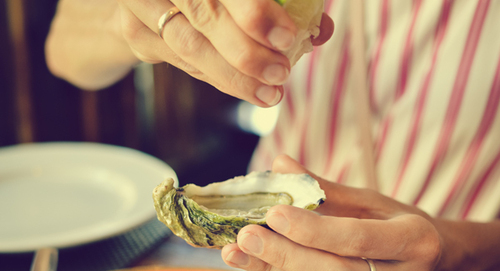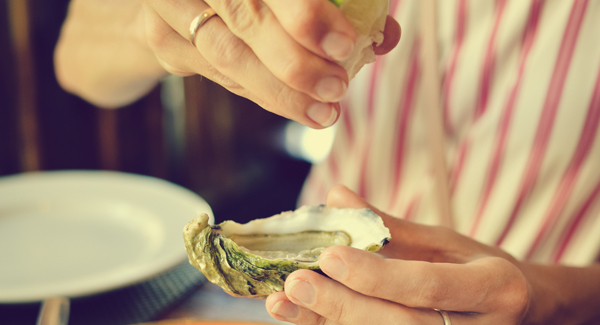

Iron, the Natural Way
Iron supplements may do more harm than good. Getting your iron from your diet, especially seafood such as oysters and scallops, is likely a better choice.
September 14, 2020 By Temma Ehrenfeld
Should adults take iron supplements? They’re a huge seller, promoted as a way of boosting energy. It’s true that up to 11 percent of older adults living on their own may be anemic. Their iron deficiency is usually mild, but still linked to decline and higher death rates.
In fact, a low red blood cell count, the classic sign of iron deficiency, is one of the most common health disorders of all adults worldwide.
However, it’s also possible to suffer from iron overload, which is linked to other dangers, so be careful with supplements. Research suggests an iron-rich diet may be a better choice. Among commonly consumed foods, shellfish is rich in bio-available iron.
A delicate balance
Iron is a mineral that makes it possible for oxygen to reach tissues throughout your body. Your bone marrow uses iron to produce hemoglobin, a protein in red blood cells. Hemoglobin picks up oxygen in the lungs, and drops it off in your tissues. It also gathers carbon dioxide and carries that back to the lungs to be exhaled.
You can get the iron you need on a daily basis only from food, or from iron your body stored when you had extra. If you do have anemia, usually the easiest way to fix it is through diet. (Hint: Do you like oysters? Scallops? Beef?)
Other possible causes of low iron are gastrointestinal bleeding, chronic kidney disease or other chronic inflammation (Lanier et al., 2018). Inflammation, which is associated with many illnesses, makes it harder for the body to absorb iron.
But dig deeper, and things quickly get more complicated. This is the body, after all, with balancing mechanisms at work in every system (Camaschella, 2013).
A liver hormone called hepcidin controls how much iron circulates. If too much hepcidin drives iron lower, you can end up with a low red blood cell count.
On the other hand, a genetic disorder called hemochromatosis drives down hepcidin. Then, your body can build up too much iron in the skin, heart, liver, pancreas, pituitary gland, and joints.
Too much iron is toxic and damages tissues over time (Pilling et al., 2019). Some speculate that the genes that lead to iron overload, which are most common among people of Celtic ancestry, may have boosted survival during the bubonic plague in Europe and Irish potato famine (Adams, 2015). But today, iron overload increases your risks of infection.
You can check your iron with a blood test, followed by genetic testing if you think you have hemochromatosis in your family or symptoms of iron overload.
Aging and iron
Your ability to synthesize heme, a precursor to hemoglobin, declines with age. Heme deficiency can lead to iron accumulation, oxidative stress, and less effective mitochondria, the structures within cells that supply them with energy.
One reason we are more vulnerable to infection as we age is sometimes excess iron accumulation, which helps pathogens sustain an infection. Older adults with unusually high levels of iron are in greater danger of liver disease, type 2 diabetes, and certain cancers.
But iron-deficient anemia is also a major problem in elders – in fact, it is among the most common disorders of old age. Older people with anemia are more likely to fall, be hospitalized, or admitted to nursing homes (Goodnough et al, 2014).
Overall, because of these risks, genes affecting iron levels are an important factor in how well you age (Timmers et al., 2020). The risk of anemia rises for people over the age of 85 and is very high in assisted-living residents.
One tip-off to anemia is fatigue. In addition, you might have pale skin and fingernails, weakness, dizziness, and headaches.
Again, the best bet to cut through the confusion for older adults is a test. Your physician can arrange a test of serum iron or serum ferritin (ferritin is a protein that helps store iron in your tissues) to determine if your levels are low, high, or just right.
Upping the iron in your diet
Both iron overload and anemia often show no symptoms, so most people don’t know they have a problem until they get a lab test. The general rule is that children, especially babies, need a lot of iron. As adults, men need eight mg of iron a day. Women need 18 mg (and more during pregnancy and breastfeeding) but after menopause, eight mg is sufficient.
Shellfish is among the best options because it contains heme iron, which is more easily absorbed than the iron in plants. Oysters are at the very top of the list of iron-rich foods, behind only fortified breakfast cereal. Three ounces of oysters could give you almost half your daily requirement. Three ounces of scallops provide 14 percent. The same amount of sardines or beef provides 11 percent of the daily value.
If you’re looking for greens, spinach has more iron than kale. Even if you don’t have a problem with gluten, you might experiment with quinoa, which is higher in protein than other grains and rich in iron and other minerals.
Importantly, eating iron-rich foods won’t necessarily tip your iron balance too high, even in those with hemochromatosis.
As one review study put it, “Although dietary iron is the source of excess iron in hemochromatosis, a decrease in dietary iron has not been shown to decrease iron stores in hemochromatosis” (Beaton, Adams, 2007). In other words, other body mechanisms appear to be at play in iron overload, not “excess” iron intake in food.
Meanwhile, high-dose iron supplementation – more than 20 milligrams – can lead to stomach upset, constipation, and other problems (Aggett, 2012).
Bottom line? As usual, whole-food sources such as quality seafood, providing a balance of nutrients in forms our bodies can recognize and use, are typically the best choice.
Sources
Adams PC. Epidemiology and diagnostic testing for hemochromatosis and iron overload. Int J Lab Hematol https://pubmed.ncbi.nlm.nih.gov/25976957/. Published May, 2015.
Aggett PJ. Iron. In: Erdman JW, Macdonald IA, Zeisel SH, eds. Present Knowledge in Nutrition. 10th ed. Washington, DC: Wiley-Blackwell; 2012:506-20.
Camaschella C. Iron and hepcidin: a story of recycling and balance. Hematology Am Soc Hematol Educ Program. https://pubmed.ncbi.nlm.nih.gov/24319154/ Published 2013
Goodnough LT, Schrier SL. Evaluation and management of anemia in the elderly. https://www.ncbi.nlm.nih.gov/pmc/articles/PMC4289144/. Published January 2014.
Hereditary Hemochromatosis. https://www.cdc.gov/genomics/disease/hemochromatosis.htm. Published July 7, 2020.
Lanier JB, Park JJ, Callahan RC. Anemia in Older Adults. Am Fam Physician https://pubmed.ncbi.nlm.nih.gov/30252420/. Published October 1, 2018.
Moen IW, Bergholdt HKM, Mandrup-Poulsen T, Nordestgaard BG, Ellervik C. Increased Plasma Ferritin Concentration and Low-Grade Inflammation-A Mendelian Randomization Study. Clin Chem https://pubmed.ncbi.nlm.nih.gov/29038157/. Published October 16, 2017.
Nemeth E, Ganz T. The role of hepcidin in iron metabolism. Acta Haematol. Published Nov., 2009. https://www.ncbi.nlm.nih.gov/pmc/articles/PMC2855274/#:~:text=Hepcidin%20is%20homeostatically%20regulated%20by,preventing%20further%20iron%20loading%20(fig.
Office of Dietary Supplements – Iron. (n.d.). Retrieved September 11, 2020, from https://ods.od.nih.gov/factsheets/Iron-HealthProfessional/
Pagani A, Nai A, Silvestri L, Camaschella C. Hepcidin and Anemia: A Tight Relationship. Front Physiol. 2019;10:1294. Published October 2019. https://www.ncbi.nlm.nih.gov/pmc/articles/PMC6794341/
Palmer WC, Vishnu P, Sanchez W, et al. Diagnosis and Management of Genetic Iron Overload Disorders. J Gen Intern Med. Published December, 2018. https://pubmed.ncbi.nlm.nih.gov/30225768/
Pilling LC, Tamosauskaite J, Jones G, et al. Common conditions associated with hereditary haemochromatosis genetic variants: cohort study in UK Biobank. https://www.ncbi.nlm.nih.gov/pmc/articles/PMC6334179/. Published January 16, 2019.
Timmers PRHJ, Wilson JF, Joshi PK, Deelen J. Multivariate genomic scan implicates novel loci and haem metabolism in human ageing. https://www.nature.com/articles/s41467-020-17312-3. Published July 16, 2020.
Office of Dietary Supplements – Iron. https://ods.od.nih.gov/factsheets/Iron-HealthProfessional/.
Beaton, M. D., & Adams, P. C. (2007). The Myths and Realities of Hemochromatosis. Canadian Journal of Gastroenterology, 21(2), 101-104. doi:10.1155/2007/619401
The original article written by Temma Ehrenfeld and posted on VitalChoice.com.
Article reposted on Markethive by Jeffrey Sloe




